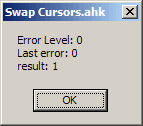[section_title title=Details]
There are three main registry keys that come into play.
- The registry key
HKEY_CURRENT_USER\Control Panel\Cursorscontains the active user cursors- The values underneath this are the different types of cursors
- The
Scheme Sourcespecifies the type of cursor scheme that is currently being used. I haven’t been able to figure out the purpose of this but I have figured out what the different values are.- 0 – Windows Default
- 1 – User Scheme
- 2 – System Scheme
- The registry key
HKEY_CURRENT_USER\Control Panel\Cursorscontains the user defined cursor schemes (i.e.Scheme Source = 1) - The registry key
HKEY_LOCAL_MACHINE\SOFTWARE\Microsoft\Windows\CurrentVersion\Control Panel\Schemescontains the system cursor schemes (i.e.Scheme Source = 2)
The cursor schemes contain the path to the cursors for the different cursor types as a comma delimited list. Below are the individual pieces.
- Arrow, Help, AppStarting, Wait, Crosshair, IBeam, NWPen, No, SizeNS, SizeWE, SizeNWSE, SizeNESW, SizeAll, UpArrow, Hand (without the leading spaces)
These names are as they would appear in the HKCU\Control Panel\Cursors. If you are a curious one you would have already changed the path to one of the cursor type in HKCU\Control Panel\Cursors and realized that it did not do anything. You are correct, just updating a key – HKCU\Control Panel\Cursors\Arrow, for instance – isn’t enough. You have to tell windows to load the new cursor.
This is where the SystemParametersInfo call comes in. To try this out let’s go ahead and change HKCU\Control Panel\Cursors\Arrow to C:\WINDOWS\Cursors\appstar3.ani (assuming you have this icon) and then make a call to SystemParametersInfo.
SPI_SETCURSORS := 0x57
result := DllCall("SystemParametersInfo", "UInt", SPI_SETCURSORS, "UInt", 0, "UInt", 0, "UInt", '0')
MsgBox Error Level: %ErrorLevel% `nLast error: %A_LastError%`nresult: %result%
If everything worked then you should see the 3D animating cursor as your default arrow and the following message box.

Changing to the Default Windows Cursor
Now the tricky part. If you look at HKLM\SOFTWARE\Microsoft\Windows\CurrentVersion\Control Panel\Schemes you will notice that “Windows Default” is defined as “,,,,,,,,,,,,,” or in other words no pointers to actual cursors!
What to do now? Don’t worry. All you have to do is set the different cursor types to empty string and then make the SystemParametersInfo call as usual. In fact, you can set any of the cursor type to empty string in any scheme and Windows will default it to it’s equivalent in the “Windows Default” scheme.
There you have it!
You also can download the complete AutoHotkey script that I wrote.
